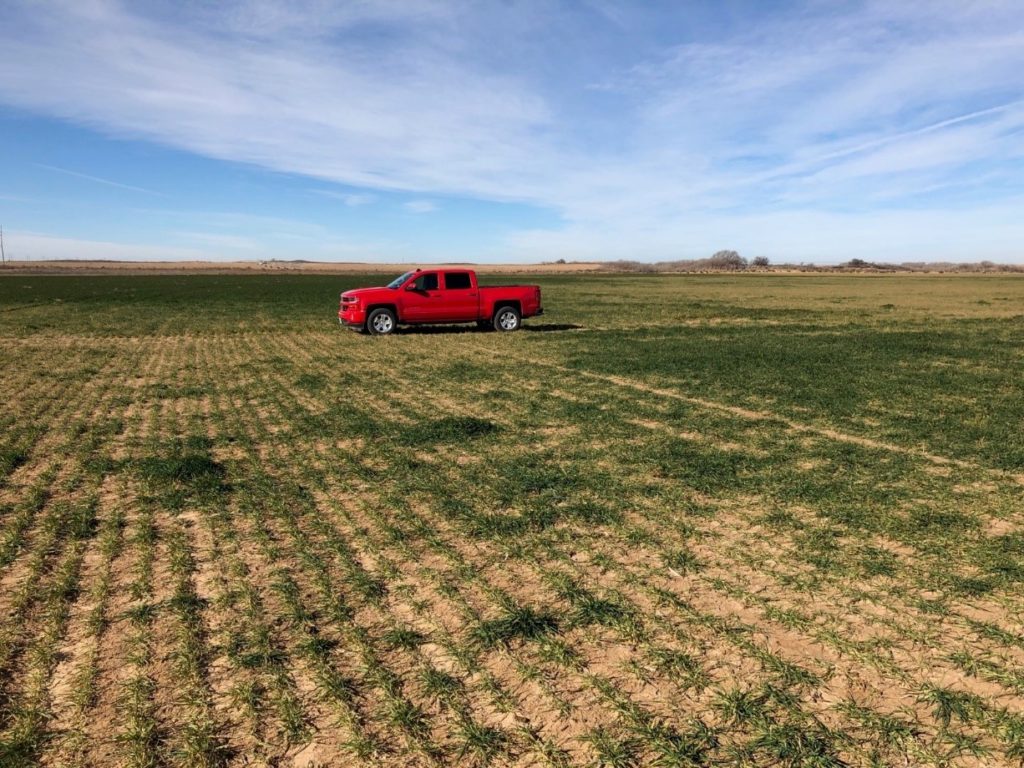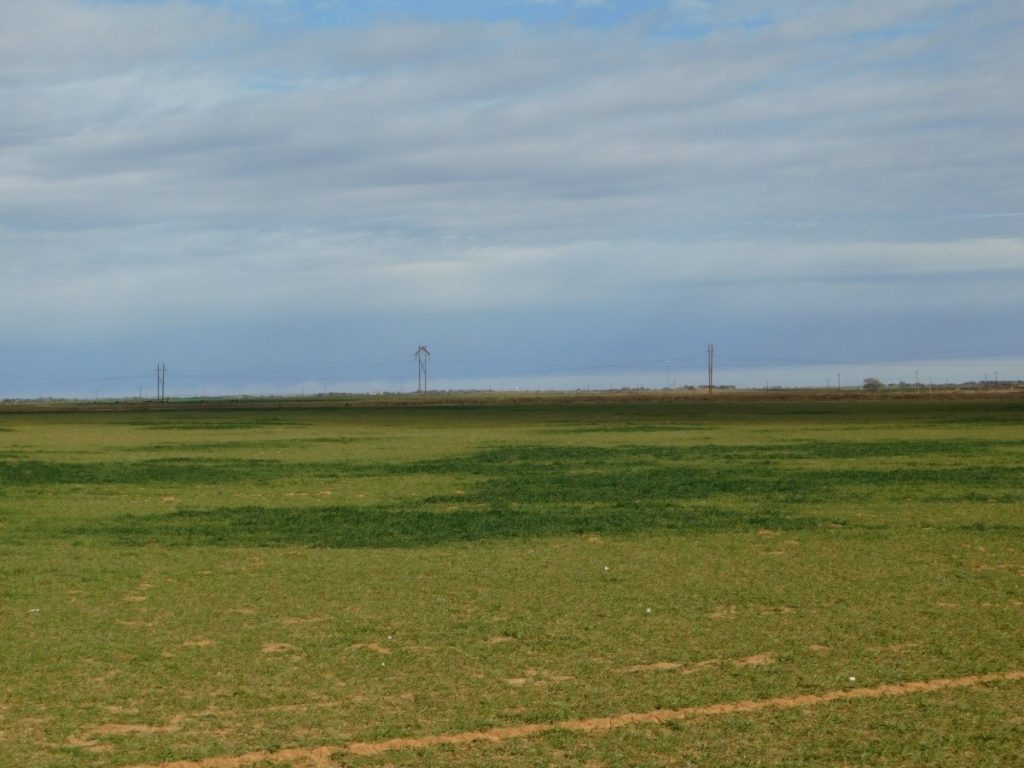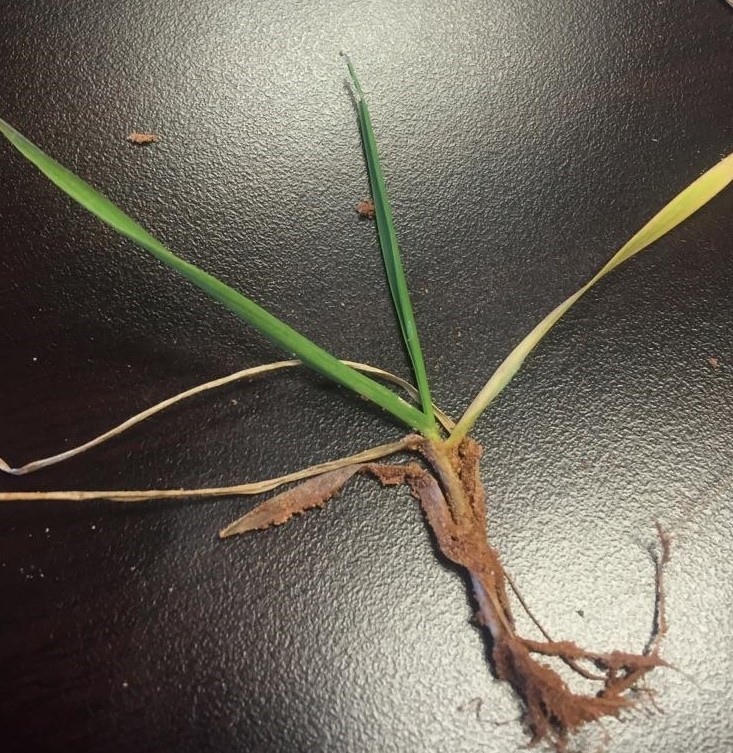by Dr. Calvin Trostle, Extension Agronomy, TAMU Soil & Crop Sciences, Lubbock, (806) 723-8432, ctrostle@ag.tamu.edu ; Dr. Reagan Noland, Extension Agronomy, TAMU Soil & Crop Sciences, San Angelo, (325) 657-7330, reagan.noland@ag.tamu.edu
For wheat producers in the Texas High Plains and lower Rolling Plains/Concho Valley Fall 2018 has brought field symptoms that have baffled some growers. Much of this is likely due to exceptionally large October rains. Essentially all fields south of Lubbock received at least 6” of rain, a few fields received twice that. Rains north of Lubbock were somewhat less. Since a month ago the inquiries we are receiving are:
- Yellow wheat south of Lubbock and in the lower Rolling Plains. This is the primary focus of this update—remember that soil available nitrogen is in the nitrate form (NO3–) which is mobile in the soil and will move with soil water.
- Leaf rust north of Lubbock. With colder temperatures this issue is greatly reduced. Though some fields indicated levels of leaf rust that were concerning, there were no fields that AgriLife Extension recommended fungicide treatment. Perhaps most importantly for the Texas High Plains, leaf rust in the fall has no connection to leaf rust in the spring.
Texas A&M AgriLife Extension plant pathologist Dr. Ken Obasa, Amarillo (806.677.5600, ken.obasa@ag.tamu.edu) and others note that in order to have leaf rust in spring fields must be re-infected with spores blown in on winds. The annual cold of winter in the Texas High Plains is enough to kill the pathogen. For more about leaf rust review Dr. Obasa’s comments at https://today.agrilife.org/2018/11/08/wheat-rust-showing-up-in-high-plains-but-treatment-not-recommended/
We believe the primary culprit in field yellowing is the loss of plant available nitrate from the wheat root zone. As noted, nitrate is mobile in soil. When you factor in large rains, nitrate will move down with percolating water. For younger wheat, this will move the needed nitrate below the root zone. As conditions dry and the root volume expands downward wheat may catch up to this nitrate. The rate of mineralization or release of other forms of nitrogen in the soil—either from organic forms or from ammonium (NH4+) from exchange sites on the negatively charged soil surface—is insufficient, at least temporarily, to meet the needs of the growing wheat. This mineralization of soil N to nitrate is slower under cool conditions.
Producers can conduct soil and plant tissue tests, and some have, to assess N status of soil and plants. Analyses that we have either conducted ourselves or received from clientele, have pointed to low and very low soil N status. If a farmer does nothing wheat may grow out of the deficiency condition as the root volume expands downward. However, if no early season N (pre-plant, at-plant, etc.) was applied and you know your residual N fertility was low, then you have a situation that would likely benefit from added N (provided you can chemigate the N if irrigated, or get a rain or snow after making a broadcast granular N application). With all the rain received farmers are naturally reluctant to consider irrigating, but if you need to add up to 0.5” of irrigation to chemigate N (or wash in broadcast N applications), do so.
If you had good fertility status at planting and you have some yellow color you might be able to wait until typical late winter top-dressing (late February, early March), but we recommend that you ensure earlier topdress application before the burst of spring growth so sharp potential N deficiency conditions are avoided.
Though we are focusing on nitrogen deficiency as the likely factor in yellow fields and poor wheat growth there are other factors that may cause significant yellowing in wheat, including several plant diseases. We are still early enough in the cropping cycle that disease issues (other than leaf rust) appear to be minor. Virus testing of wheat tissue samples in Dr. Obasa’s plant pathology lab in Amarillo to date have generally recorded at most low and undetectable levels of wheat streak mosaic virus, triticum mosaic virus, High Plains virus, and barley yellow dwarf mosaic virus.
AgriLife Extension Resource for Yellowing Wheat
For more scenarios that could lead to yellowing of wheat foliage, consult Texas A&M AgriLife’s “Potential Causes of Yellowing During the Tillering Stage of Wheat in Texas,” ESC-040 (April 2016) at http://publications.tamu.edu/WHEAT/2016/Yellow%20wheat%20publication.pdf
Field Descriptions of Famers’ Yellow Wheat Fields
We will use five photographs from producers’ fields to further outline the issues we have observed with yellowing in regional wheat fields.
Figure 1: This Castro Co. field ranges from spotty green vs. poor growth in the foreground, all poor and light color in the upper right, and the upper left is all green. Dr. Obasa commented that leaf rust would not create such a spotty appearance. No leaf rust pustules were observed. Some of the patchy green (at least for spots that are 1-2’ in size) leads one to wonder if there is a general (temporary) deficiency of N, and the green spots are where grazing cattle in the past defecated or urinated. But the dark green area beyond the pickup to the left doesn’t fit that scenario. We did not find larger field patterns that might indicate chemical drift or active residual herbicide. The October rainfall on this field was at least 5”.
Roots in Fig. 1 plants look fine and no insects have been found. White grubs are also not an issue. These cause expanding yellow spots, typically in fields that have been in continuous wheat for 7 years or more. Until it gets cold and grubs move deeper in the soil, grubs sever the root system just below the crown killing the plant. If they are present, you will easily find them in the transition between dead and normal plants.

Fig. 1. Spotty wheat growth, Castro Co., Texas. The pattern is puzzling as there is no apparent reason for poor, mixed, and good areas n the field. There is essentially no slope that would potentially pond water and lead to increase nitrate leaching potential (hence N deficiency). (Photo: Quillin consulting)
** ** **
Figure 2. The field is characterized by sandy soil. So leaching potential for soil nitrate is high. The soil test reports comparing good and poor areas do not distinguish one area from the other (soil nitrate N was ‘very low,’ 2 to 3 ppm). The farmer chemigated and put out dry nitrogen. Rainfall again was high at 5 to 8” on different fields in the area. Typically, we expect more yellowing in low areas or small local depressions where rainwater may have ponded and so there was added leaching. The spottiness in Fig. 2 looks like the green areas might be where soils are slightly elevated thus run-off from a large rain moved to the side and percolated down elsewhere, leaving slightly more nitrate in the high areas.

Fig. 2. Wheat on sandy soil, northern Lamb Co., TX. This and surrounding fields in the sandy area demonstrate spotty good growth. Soil and plant tissue tests of good and poor areas all report low N. (Photo: Marcus Sullivan)
** ** **
Figure 3. This Jones Co. field has noticeable green strips where tractor and drill equipment tires ran. This is one of two fields in Jones Co., and other fields with similar symptoms have been reported the week of Dec. 17 in Runnels Co. AgriLife Extension conducted soil and tissue sampling in this field for green strips vs. yellow areas. The wheat in the tracks had higher tissue N, but N was at least sufficient in yellow areas. (The average of three samples of track green vs. general yellow was 4.2% N vs. 2.8% N. Differences in soil N were not found (the opportunity to capture that difference may have already passed). Local NRCS staff tested soil compaction with a penetrometer, but there was not enough resistance in any part of the field to show measurable compaction, as the field was deep-ripped prior to planting and soils were coarse-textured. Our best guess is that shallow compaction from the wheels resulted in less N loss via leaching as some water may have moved to the side leaving a pocket of higher soil N under the wheel track.

Fig. 3. Wheel tracks in two directions have greener wheat, Jones, Co. Texas. More firm soil in the tracks may have directed some leaching water to the side thus reducing potential downward movement of nitrate below the wheel track. (Photo: Reagan Noland)
** ** **
Figure 4. Seedling wheat from Dawson Co. Rainfall on this field was over 8” in October and the field had a yellow appearance. Note the youngest leaf is darker green. This is a symptom of nitrogen behavior in wheat and other plants as N will be moved from older tissues to the growing point and newly emerging leaves. If the youngest leaf is also yellow then there is potentially acute N deficiency, or some other issue occurring. (Photo: Roy Paske)
Figure 5. Wheat sample from the field in Fig. 2 with reduced N status (soil N, ‘very low’; plant tissue N, ‘low’) on a sandy soil. Root mass looks good indicating that wheat has grown well, perhaps before heavy rains leached available nitrate. Also, the youngest leaf (orange arrow) is green indicating the plant response to N deficiency. (Photo: Marcus Sullivan)
What do I do with current yellow wheat?
The guess work comes after you have documented low soil test nitrate and possibly low plant tissue N. As noted above, if you have not applied any N fertility to this season’s wheat crop then you may consider if you should proceed with an N application or wait until you approach the typical late winter topdressing season in late February and early March. If your field has been yellow for some time and you don’t notice much improvement, then nitrogen may be merited.
Management considerations also depend on your objectives for the wheat crop. The immediate risk with “waiting to see what happens” is not as high with wheat being managed for grain, since most opportunity for fall tillering has passed, and the possibility exists that the wheat roots could still catch up to leached N. If the wheat is needed quickly for winter grazing, then immediate action may be justified (considering livestock production potential), especially if N has been leached beyond a recoverable range.
If you conclude that a light winter N application may be called for, review the principles of N top dressing in wheat at https://agrilifecdn.tamu.edu/lubbock/files/2014/02/Wheat-N-Topdress-Trostle-Master-Feb2014-High-Plains.pdf (PowerPoint) and https://lubbock.tamu.edu/files/2018/02/TopDress-N-Tips-for-Wheat-2018.pdf (Word file).
Here is an additional tip that may give you confidence in how your wheat may respond to added nitrogen. You can do this two ways:
- Measure a 28’ X 28’ square on each end of the field. Apply 1 lb. of urea (46% N; I recommend urea as there is no other nutrient in the fertilizer) evenly over the square. This alone will not help you know whether your soil responds to the N. You need incorporation. So, do this either in front of an irrigation pass or when rain or snow chances are high. This is equal to 25 lbs. of actual N per acre (or 54 lbs. of urea per acre).
- If you don’t have irrigation and rain or snow is not imminent, then try a different method. Measure a 4’ X 4’ square. Use a hoe to make a small dike of soil around the square. Sprinkle in a small amount of urea (double the 25 lb. N rate above would be 2/3 ounce or 18 grams, if you have a small scale). Sprinkle 5 gallons of water into the area, which is equal to 0.5” of rain. Be careful to not allow the water to push the nitrogen to the side. To ensure that any green-up is not due to the water alone, you need to repeat this with a second square but add the water only. (I use the higher N rate here as the water you sprinkle in will not have as much time to dissolve the urea granules like an irrigation or rain would.)
The above are measured approaches. You can of course simply sling some N on the field, or if you have a large water tank then spray areas with and without added urea and see what happens. Nitrate assimilation into plants is relatively quick. If there is an N deficiency you should notice a difference in appearance within 3 to 5 days. Take a picture of each test plot with your phone so you can compare before and after and not rely completely on your perception. Any response you observe should help you determine whether to fertilize the field.

Calvin Trostle
Professor and Extension Specialist
Lubbock, TX
803.746.6101
ctrostle@ag.tamu.edu
